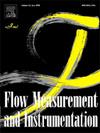Design of a Contactless Inductive Flow Tomography system for a large Rayleigh–Bénard convection cell with aspect ratio Γ=0.5
IF 2.3
3区 工程技术
Q2 ENGINEERING, MECHANICAL
引用次数: 0
Abstract
Contactless Inductive Flow Tomography (CIFT) is a flow measurement technique that is able to reconstruct the time-dependent three-dimensional velocity field in electrically conducting fluids, e.g., liquid metals, from magnetic field measurements. The paper describes the design of a specific CIFT measurement set-up for flow studies in liquid metal Rayleigh–Bénard convection (RBC) in a large cylinder of aspect ratio (diameter/height) of filled with the ternary alloy GaInSn as model fluid. An optimized configuration for the CIFT excitation system and magnetic field sensor layout under consideration of the specific requirements for the application in turbulent RBC is determined by numerical simulations. The new experimental CIFT-RBC system resulting from the design process is constructed and a preliminary experiment at a Rayleigh number of and a Prandtl number of is performed and evaluated.
为纵横比 Γ=0.5 的大型雷利-贝纳德对流电池设计非接触式感应流动断层扫描系统
非接触式电感流动断层扫描(CIFT)是一种流动测量技术,能够通过磁场测量重建导电流体(如液态金属)中随时间变化的三维速度场。本文介绍了一种特定的 CIFT 测量装置的设计,用于在一个长径比(直径/高度)为 Γ=0.5 的大型圆柱体中研究液态金属雷利-贝纳德对流(RBC)的流动情况,圆柱体中充满了三元合金 GaInSn 作为模型流体。根据湍流 RBC 应用的具体要求,通过数值模拟确定了 CIFT 激励系统和磁场传感器布局的优化配置。根据设计过程构建了新的 CIFT-RBC 实验系统,并在雷利数 Ra=2.13×107 和普朗特数 Pr=0.03 的条件下进行了初步实验和评估。
本文章由计算机程序翻译,如有差异,请以英文原文为准。
求助全文
约1分钟内获得全文
求助全文
来源期刊

Flow Measurement and Instrumentation
工程技术-工程:机械
CiteScore
4.30
自引率
13.60%
发文量
123
审稿时长
6 months
期刊介绍:
Flow Measurement and Instrumentation is dedicated to disseminating the latest research results on all aspects of flow measurement, in both closed conduits and open channels. The design of flow measurement systems involves a wide variety of multidisciplinary activities including modelling the flow sensor, the fluid flow and the sensor/fluid interactions through the use of computation techniques; the development of advanced transducer systems and their associated signal processing and the laboratory and field assessment of the overall system under ideal and disturbed conditions.
FMI is the essential forum for critical information exchange, and contributions are particularly encouraged in the following areas of interest:
Modelling: the application of mathematical and computational modelling to the interaction of fluid dynamics with flowmeters, including flowmeter behaviour, improved flowmeter design and installation problems. Application of CAD/CAE techniques to flowmeter modelling are eligible.
Design and development: the detailed design of the flowmeter head and/or signal processing aspects of novel flowmeters. Emphasis is given to papers identifying new sensor configurations, multisensor flow measurement systems, non-intrusive flow metering techniques and the application of microelectronic techniques in smart or intelligent systems.
Calibration techniques: including descriptions of new or existing calibration facilities and techniques, calibration data from different flowmeter types, and calibration intercomparison data from different laboratories.
Installation effect data: dealing with the effects of non-ideal flow conditions on flowmeters. Papers combining a theoretical understanding of flowmeter behaviour with experimental work are particularly welcome.
 求助内容:
求助内容: 应助结果提醒方式:
应助结果提醒方式:


